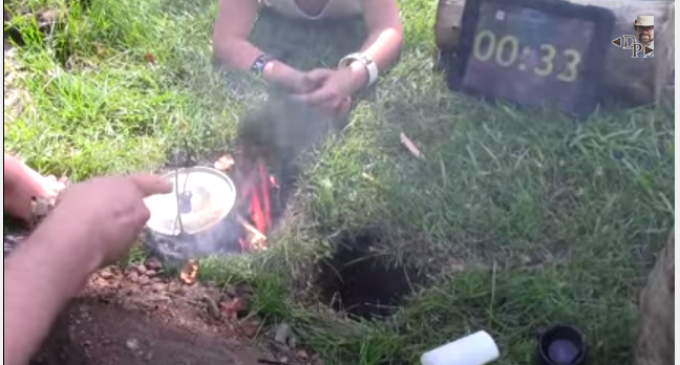
A Dakota fire hole requires much less firewood and burns more efficiently, producing hotter fires with less wood. This makes it a very valuable wilderness survival technique in places where firewood is scarce or requires much effort to obtain.
It also creates a stable platform that is very convenient for cooking.
The fire is concealed within a hole limiting the amount of visible light emitted and smoke is also decreased because the wood is burning hotter and more efficiently.

actually you can build a less fire using a klondike fire , all you need are twigs
Also found in the good ol’ boy scout hand book.
Typical BSA fire, safe sound and sweet
You guys saying a fire will.travel underground 50 feet and start a forest fire are full of p**p. No such thing ever documented.
Besides, if it WERE true, all you would have to do to prevent that is.make sure there are no exposed roots in the firehole.
Stupid, ignorant.people retelling old folk tales.some idiot environmentalist told them.
All you need is a handful of firewood kindling wood to boil water or cook a foil.dinner.
Ragman says:
“55 years ago we use to win all the fire building contests in the Boy Scouts by using this method. Hardest and slowest part is digging the holes.
Thanks for the memories.”
From: http://www.truthandaction.org/build-dakota-fire-hole/comment-page-6/#comment-847433
55 years ago we use to win all the fire building contests in the Boy Scouts by using this method. Hardest and slowest part is digging the holes.
Thanks for the memories.
Truth and Action – Ragman- I was a Royal Ranger Commander for 21 years and have been a Scoutmaster for 25. My son is an Eagle Scout and also a Scoutmaster. We have used this type of fire when conditions call for a quick fire or it is windy or backpacking all that time. I used it in the field when I worked security for the State Dept for quick coffee. It is the fastest and safest fire there is to use.
Also, under current BSA “Leave No Trace” practices, we teach boys to disturb as little soil as possible for a fire and this old tried and true method fits that.perfectly. Scouts are taught to remove the sod, then make the fire hole or pit. When the fire is out and coals are cool, the sod is replaced and the remnants of the coals- potash, sulfur, etc provide a bed of nutrients to help the sod re-establish. The water (and/or urine, excrement disposal) in the fire pit also help with this.
SO- there is a lot more to this little “cathole fire” than meets the eye, eh?
look at this Ted Spangenberg Jr., Ted Spangenberg and Chris Crawford
Awesome post